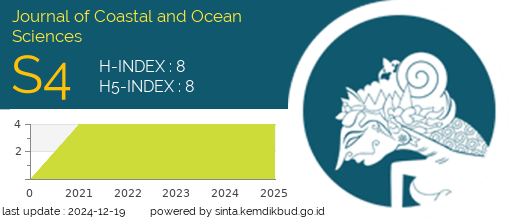Composition of Catches on Bottom Gill Net Fishing Gear in Sedanau Waters of Natuna Regency
DOI:
https://doi.org/10.31258/Keywords:
Bottom Gillnet, Catch Result, SedanauAbstract
The bottom gill net is one of the fishing gears made from a rectangular net installed at the bottom of the water. The basic gill net construction used is a net thread made of monofilament polyamide material, the size of the fishing gear used is a net length of 2.50 meters, a net body width of 1.5 meters, and a mesh size of 3 inches. Knowing the state of the environment is a very important reason to increase the catch by using environmental parameters such as physical parameters that are easier to observe. The main fishing items are Coral Pond (Lethrinus lentjan), Timunan (Lutjanidae vitta), Yellowtail (Lutjanus fulviflamma), Red Snapper (L.bitaeniatus), and Kuwe (Caranx ignobilis). Bycatch is Black Pomfret (Parastromateus niger), Seminyak (Plectorhinchus), Gerut (Pamadasys maculatus), Stingray (Dasyatis sp), Lepu Batu (Pterois volitans), and Crab (Portunidae). This study aims to determine the composition of the catch. This research was carried out in Sedanau waters in Natuna Regency, Riau Islands Province for 7 days in February 2022 using the survey method. One unit of basic gill mesh is operated to collect data and is analyzed by analysis of the composition of types and weights. The results showed that 11 types of fish were caught and dominated by Yellowtail (L.fulviflamma) as many as 77 with a percentage value of 26.46%.
Downloads
References
[DKP] Dinas Perikanan Kabupaten Natuna. (2017). Statistik Perikanan Kabupaten Natuna. DKP Kabupaten Natuna. Ranai.
Akiyama, S. (1997). Discarded Catch of Set-net Fisheries In Tateyama Bay. Journal of the Tokyo. University of Fisheries.
Broadhurst, M.K. (2000). Modifications to Reduce Bycatch in Prawn Trawls: A Review and Framework for Development. Rev. Fish Biol. Fish., 10(1): 27–60.
Catchpole, T.L., Frid, C.L.J., Gray, T.S. (2004). Discarding in the English north-east coast Nephrops norvegicus fishery: the role of social and environmental factors. Fisheries Research. 72: 45-54.
Hall, S.J., Mainprize, B.M. (2005). Managing Bycatch and Discards: How Much Progress Are We Making and How Can We Do Better? Fish Fish, 6(2): 134–155.
Harrington, J.M., Myers, R.A., Rosenberg, A.A. (2005). Wasted Fishery Resources: Discard By-catch in the USA. Fish and Fisheries, 6: 350-361.
Hutomo, M., Baharuddin, A., Djamali, S., Martosewojo, S. (1987). Sumberdaya Ikan Teri di Indonesia. Pusat Penelitian dan Pengembangan Oceanologi - LIPI. Jakarta.
Jennings, S. (2005). Indicators to Support An Ecosystem Approach to Fisheries. Fish and Fisheries. 6: 212-232.
Jennings, S. (2007). Reporting and Advising on the Effect of Fishing. Fish and Fisheries, 8: 269-276.
Kelleher, K. (2005). Discards in the World’s Marine Fisheries: An Update. FAO Fisheries Technical Paper No. 470. Rome, Italy: Food and Agriculture Organization of the United Nations.
Putri, V.L., Kurohman, F., Fitri, A.D.P. (2018). Efisiensi Teknis dan Selektivitas Alat Tangkap Jaring Insang (Gill Net) terhadap Komposisi Hasil Tangkapan di Perairan Semarang. Semarang. Universitas Diponegoro






